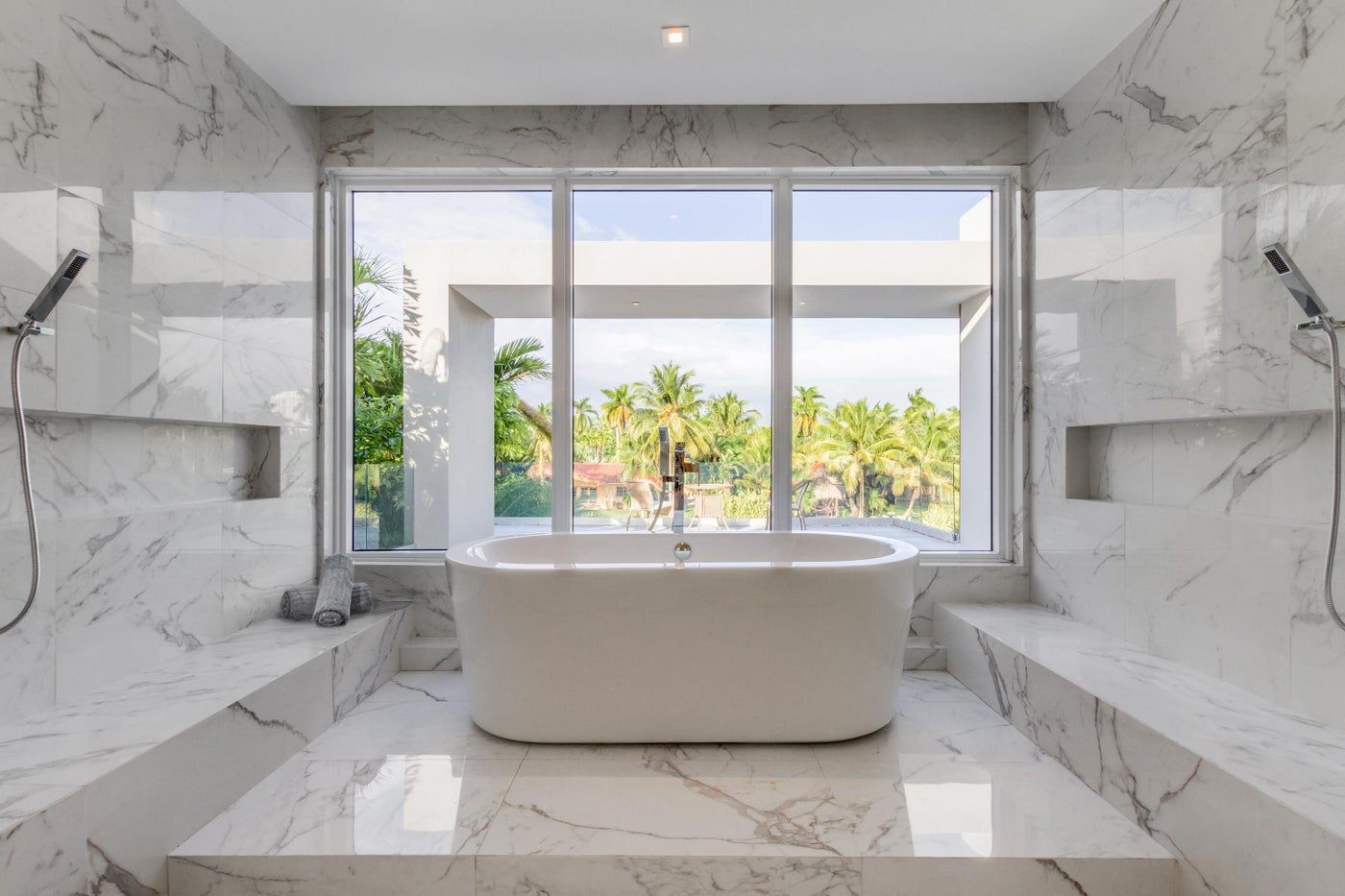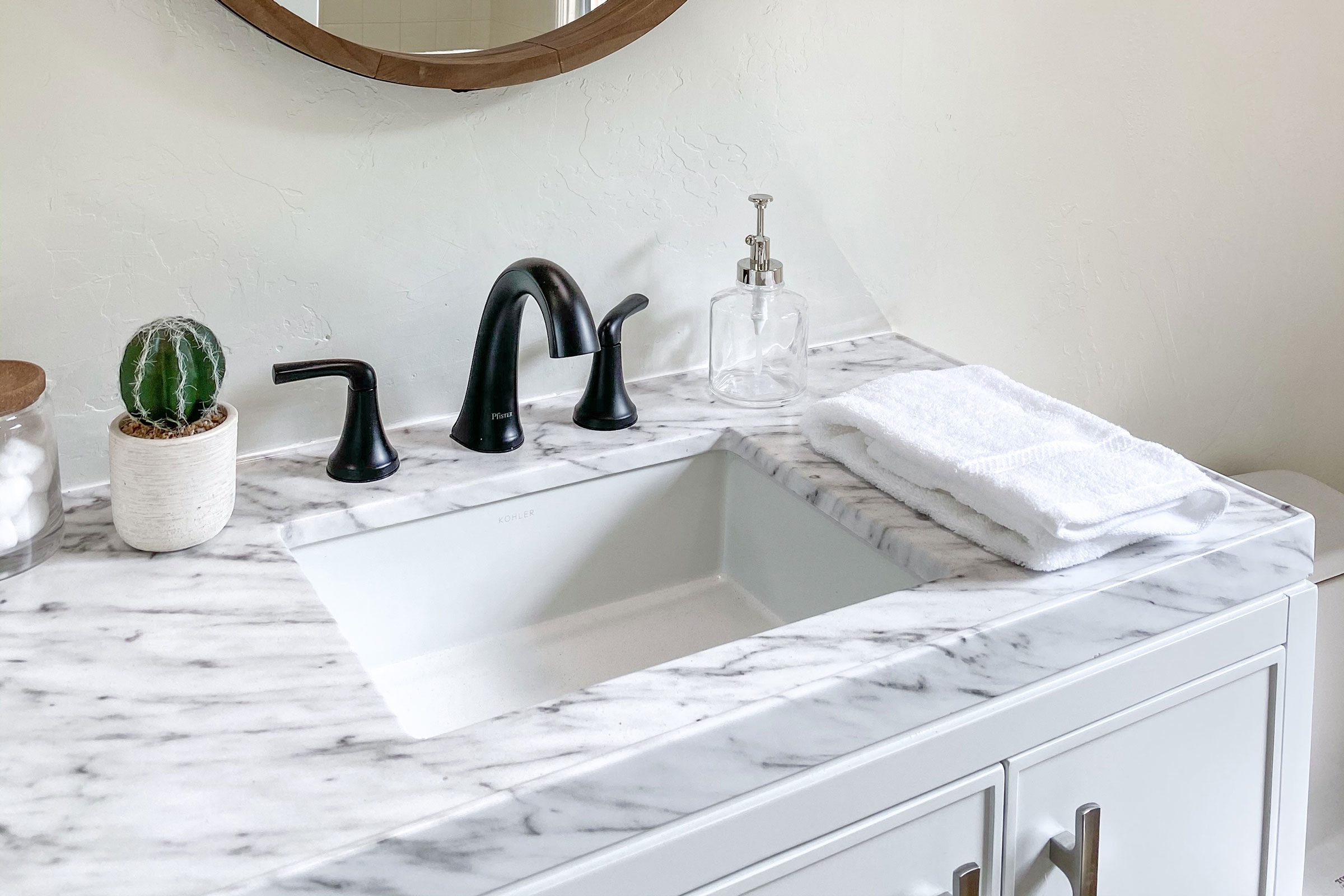Marble Top Bathroom Furniture


Marble top bathroom furniture adds a touch of luxury and sophistication to any bathroom. From vanities to cabinets, consoles, and shelves, there’s a wide variety of options available to suit different styles and needs.
Types of Marble Top Bathroom Furniture
Marble top bathroom furniture comes in a variety of styles and designs.
- Vanities: Marble top vanities are the most common type of marble bathroom furniture. They typically feature a large countertop with integrated sinks, providing ample space for storage and grooming.
- Cabinets: Marble top cabinets offer a stylish and practical storage solution for toiletries, towels, and other bathroom essentials. They can be freestanding or wall-mounted, depending on the available space.
- Consoles: Marble top consoles are slim and elegant pieces of furniture that can be used as a vanity, a decorative accent, or a storage solution. They are ideal for smaller bathrooms where space is limited.
- Shelves: Marble top shelves provide a stylish and functional way to display decorative items, towels, or toiletries. They can be installed on walls or freestanding units.
Advantages of Marble in Bathroom Furniture
Marble is a popular choice for bathroom furniture due to its many advantages.
- Durability: Marble is a highly durable material that can withstand scratches, stains, and heat. It is also resistant to moisture and mildew, making it an ideal choice for humid bathroom environments.
- Elegance: Marble is known for its natural beauty and elegance. Its unique veining patterns and polished finish create a luxurious and sophisticated look.
- Natural Beauty: Marble is a natural stone, meaning that each piece is unique and has its own distinctive character. Its natural veining patterns and color variations add a touch of warmth and personality to any bathroom.
Types of Marble Used in Bathroom Furniture
Different types of marble are used in bathroom furniture, each with its own unique characteristics.
- Carrara Marble: Carrara marble is a classic choice for bathroom furniture. It is known for its white background with delicate gray veining. It is a relatively soft marble, so it may be more susceptible to scratches.
- Calacatta Marble: Calacatta marble is similar to Carrara marble but has a more dramatic veining pattern. It features bold, swirling veins that create a luxurious and eye-catching look. It is also a relatively soft marble.
- Statuario Marble: Statuario marble is known for its pure white background with bold, gray veining. It is a very expensive marble, but its elegance and beauty make it a popular choice for high-end bathroom furniture.
- Nero Marquina Marble: Nero Marquina marble is a black marble with distinctive white veining. It creates a dramatic and sophisticated look in bathrooms.
Design Considerations for Marble Top Bathroom Furniture

Marble top bathroom furniture adds a touch of elegance and sophistication to any bathroom. Its natural beauty and durability make it a popular choice for homeowners looking to enhance their bathroom’s aesthetic appeal. However, selecting the right marble and design elements is crucial to achieve the desired look and feel.
Marble Color and Veining Impact
The color and veining of marble significantly influence the overall aesthetic of a bathroom. Lighter marble colors, such as white or cream, create a sense of spaciousness and brightness, while darker marble colors, such as black or gray, can add a touch of drama and sophistication. Veining patterns, which are the natural lines and swirls in the marble, can range from subtle to bold. Subtle veining blends seamlessly with the background color, creating a clean and elegant look. Bold veining, on the other hand, adds visual interest and creates a focal point in the bathroom.
Design Styles
Marble top bathroom furniture complements various design styles, each with its own unique aesthetic.
Traditional Style
Traditional bathrooms often feature classic elements like clawfoot tubs, ornate mirrors, and detailed moldings. Marble top furniture in traditional styles typically features intricate carvings, detailed moldings, and warm color palettes. White or cream marble with subtle veining is a popular choice for traditional bathrooms, as it complements the classic elegance of the design.
Modern Style
Modern bathrooms are characterized by clean lines, minimalist designs, and a focus on functionality. Marble top furniture in modern styles often features sleek and geometric shapes, with minimal ornamentation. Black or gray marble with bold veining can add a touch of drama and sophistication to a modern bathroom, while white marble with subtle veining can create a clean and minimalist look.
Contemporary Style
Contemporary bathrooms blend elements of modern and traditional styles, creating a unique and eclectic look. Marble top furniture in contemporary styles can range from sleek and minimalist to more ornate and detailed. The choice of marble color and veining depends on the overall aesthetic of the bathroom, but both bold and subtle veining can be incorporated to create a unique and visually appealing design.
Incorporating Marble Top Furniture into Different Bathroom Layouts
The size and layout of the bathroom can influence how marble top furniture is incorporated.
Small Bathrooms
In small bathrooms, it’s important to choose marble top furniture that is compact and doesn’t overwhelm the space. A small vanity with a marble top can provide ample storage without taking up too much floor space. Light-colored marble with subtle veining can help to create a sense of spaciousness.
Large Bathrooms
Large bathrooms offer more flexibility in terms of furniture placement and design. A large vanity with a marble top can be a focal point in the bathroom, while smaller marble top pieces, such as side tables or shelves, can be used to add storage and style. Bold veining can be incorporated to create a dramatic and eye-catching design.
Open Concept Bathrooms
Open concept bathrooms, which often combine the bathroom and bedroom or living area, require careful consideration of the design elements. Marble top furniture should complement the overall aesthetic of the space and create a cohesive look. Light-colored marble with subtle veining can help to create a sense of continuity between the different areas.
Marble Top Bathroom Furniture


Marble is a beautiful and durable material that can add elegance and sophistication to any bathroom. However, it requires proper care and maintenance to preserve its beauty and longevity.
Marble Top Bathroom Furniture: Care and Maintenance
Marble is a porous material that is susceptible to staining, etching, and water damage. To maintain the beauty and durability of marble top bathroom furniture, it’s essential to follow proper cleaning and sealing techniques.
- Regular Cleaning: Dust and debris should be wiped away regularly using a soft, dry cloth. For deeper cleaning, use a mild pH-neutral cleaner specifically designed for marble. Avoid using acidic cleaners, such as vinegar, lemon juice, or harsh abrasives, as they can damage the marble’s surface.
- Sealing: Sealing marble is crucial to protect it from stains and etching. A sealant creates a protective barrier that prevents liquids and oils from penetrating the marble’s pores. Apply a high-quality marble sealant every 6-12 months, or more frequently in high-traffic areas.
- Water Damage: Promptly dry any spills or water droplets on the marble surface. Prolonged exposure to water can lead to etching or staining. For stubborn stains, consult a professional stone cleaning company.
Common Issues with Marble in Bathrooms
Marble is susceptible to certain issues in bathroom settings, including staining, etching, and water damage.
- Staining: Stains occur when liquids or substances penetrate the marble’s pores and leave behind a discoloration. Common culprits include coffee, tea, wine, and rust. The best way to prevent staining is to seal the marble regularly and clean up spills immediately.
- Etching: Etching is a dulling or frosting of the marble surface caused by acidic substances. Acidic cleaners, lemon juice, and even acidic foods can etch marble. To prevent etching, avoid using acidic cleaners and promptly clean up spills.
- Water Damage: Prolonged exposure to water can cause watermarks, etching, and even cracks in marble. Always dry spills immediately and consider using a water-resistant sealant to protect the marble surface.
Preventative Measures and Solutions
Taking preventative measures can significantly reduce the risk of issues associated with marble in bathroom settings.
- Regular Cleaning and Sealing: Regular cleaning and sealing are essential for protecting marble from stains, etching, and water damage. Follow the cleaning and sealing recommendations mentioned earlier.
- Use Coasters and Trivets: Place coasters under glasses, cups, and other items to prevent rings and stains. Use trivets under hot dishes to avoid heat damage.
- Avoid Acidic Cleaners: Use pH-neutral cleaners specifically designed for marble. Avoid using acidic cleaners, such as vinegar, lemon juice, or harsh abrasives.
- Promptly Clean Spills: Clean up spills immediately to prevent staining and etching. Use a soft cloth and a mild cleaner to remove any residue.
- Professional Cleaning: For stubborn stains or deep cleaning, consult a professional stone cleaning company. They have the expertise and equipment to restore the beauty of your marble.
